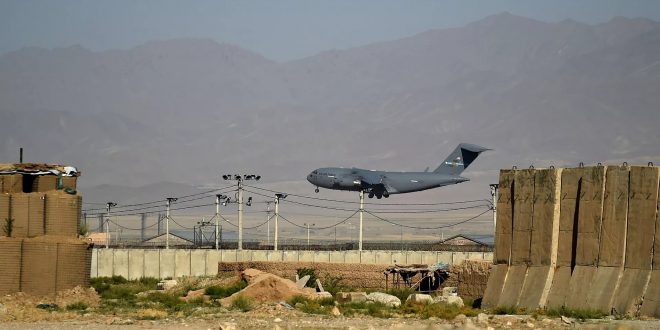02-07-2021
Bureau Report + Agencies
KABUL/ ISLAMABAD: After nearly 20 years, the United States military has left Afghanistan’s Bagram airbase, the epicenter of its war to remove the Taliban and hunt down the al-Qaeda perpetrators of the 9/11 attacks, two US officials have said.
The airbase was handed over to the Afghan National Defense and Security Forces in its entirety, they said on Friday on condition of anonymity because they were not authorized to release the information to the media, The Associated Press reported.
One of the officials also said the US top commander in Afghanistan, General Austin S Miller, “still retains all the capabilities and authorities to protect the forces”.
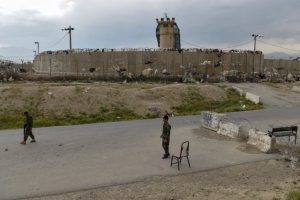 At its peak, Bagram airbase saw more than 100,000 US troops pass through its sprawling compound 50km (30 miles) north of capital, Kabul.
At its peak, Bagram airbase saw more than 100,000 US troops pass through its sprawling compound 50km (30 miles) north of capital, Kabul.
An Afghan official said the base would be officially handed over to the government at a ceremony on Saturday, media reported.
The withdrawal from the airbase is the clearest indication that the last of the 2,500-3,500 US troops have left Afghanistan or are nearing a departure, months ahead of President Joe Biden’s promise that they would be gone by September 11.
It was clear soon after the mid-April announcement that the US was ending its “forever war,” that the departure of US soldiers and their estimated 7,000 NATO allies would be nearer to July 4, when the country celebrates its Independence Day.
Most NATO soldiers have already exited Afghanistan as of this week.
Announcements from several countries analyzed by The Associated Press show that a majority of European troops left with little ceremony – a stark contrast to the dramatic and public show of force and unity when NATO allies lined up to back the US invasion in 2001.
The US has refused to say when the last of its soldiers would leave Afghanistan, citing security concerns, but also the protection of Kabul’s Hamid Karzai International Airport that is still being negotiated. Turkish and US soldiers currently protect the airport.
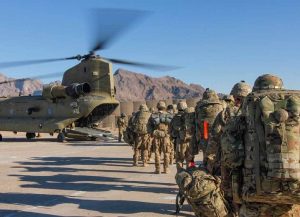 The US will also have about 6,500 troops in Afghanistan to protect its sprawling embassy in the capital. Their presence it is understood will be covered in a bilateral agreement with the Afghan government.
The US will also have about 6,500 troops in Afghanistan to protect its sprawling embassy in the capital. Their presence it is understood will be covered in a bilateral agreement with the Afghan government.
The US and NATO leaving Afghanistan come as Taliban fighters make strides in several parts of the country, overrunning dozens of districts and overwhelming the beleaguered Afghan Security Forces.
In a worrying development, the government has resurrected militias with a history of brutal violence to assist the Afghan security forces.
‘Taliban at the door of Kabul’
At what had all the hallmarks of a final press conference, General Miller this week warned that continued violence risked a civil war in Afghanistan that should have the world worried?
Last month, Biden told his Afghan counterpart, Ashraf Ghani, that “Afghans are going to have to decide their future, what they want”.
Ghani said his job was now to “manage the consequences” of the US withdrawal.
The agreement with the Taliban on the US pullout was struck under the administration of former President Donald Trump.
In exchange for the US withdrawal, the Taliban has vowed to prevent any armed group from launching international attacks from the Afghan soil.
The group has also made a commitment to enter into talks with their Afghan rivals but little progress has been made in negotiations.
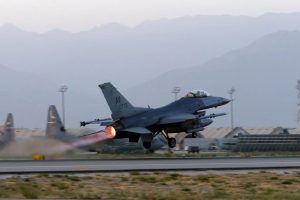 Speaking to media, Faiz Zaland, political commentator and professor at Kabul University, said the pulling out of US troops is “a bit hasty in the current situation because we don’t have peace on the ground”.
Speaking to media, Faiz Zaland, political commentator and professor at Kabul University, said the pulling out of US troops is “a bit hasty in the current situation because we don’t have peace on the ground”.
“The withdrawal is happening right at a time when the Taliban is at the door of Kabul,” he said.
“There are severe and harsh fights going on all over the country. More than 80 districts have fallen into the hands of the Taliban in the past one month,” he said, calling June “the deadliest month for Afghan forces in the past two decades”.
Zaland said the US is making an “irresponsible exit” by leaving before an intra-Afghan peace deal has been finalized.
“It does seem likely that the country might be heading towards a civil war,” he told media.
Rife with symbolism
The US departure is rife with symbolism. Not least that it is the second time that an invader of Afghanistan has come and gone through Bagram.
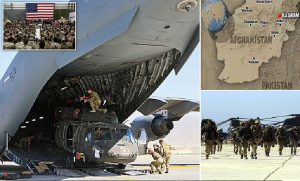 The former Soviet Union built the airfield in the 1950s. When it invaded Afghanistan in 1979 to back a communist government, it turned it into its main base from which it would defend its occupation of the country.
The former Soviet Union built the airfield in the 1950s. When it invaded Afghanistan in 1979 to back a communist government, it turned it into its main base from which it would defend its occupation of the country.
For 10 years, the Soviets fought the US-backed “mujahideen”, dubbed freedom fighters by the then President Ronald Reagan, who saw them as a front-line force in one of the last Cold War battles.
When the US and NATO inherited Bagram in 2001, they found it in ruins, a collection of crumbling buildings, gouged by rockets and shells, most of its perimeter fence wrecked.
It had been abandoned after being battered in the battles between the Taliban and rival warlords fleeing to their northern enclaves.
The enormous base has two runways. The most recent, at 12,000 feet (3,660 metres) long, was built in 2006 at a cost of $96m. There are 110 revetments, which are basically parking spots for aircraft, protected by blast walls.
Global Security, a security think-tank, says Bagram includes three large hangars, a control tower and numerous support buildings.
The base has a 50-bed hospital with a trauma bay, three operating theatres and a modern dental clinic. Another section houses a prison, notorious and feared among Afghans.
 Pressmediaofindia
Pressmediaofindia
